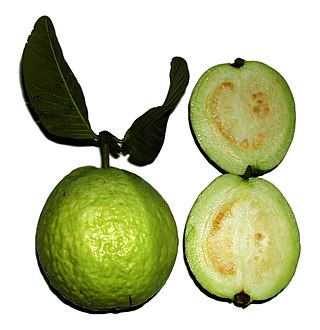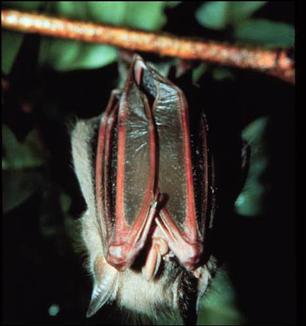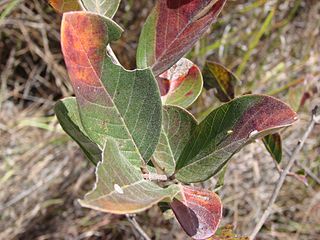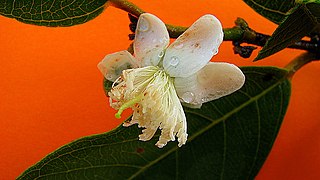
Guava is a common tropical fruit cultivated in many tropical and subtropical regions. The common guava Psidium guajava is a small tree in the myrtle family (Myrtaceae), native to Mexico, Central America, the Caribbean and northern South America. The name guava is also given to some other species in the genus Psidium such as strawberry guava and to the pineapple guava, Feijoa sellowiana. In 2019, 55 million tonnes of guavas were produced worldwide, led by India with 45% of the total. Botanically, guavas are berries.

Myrtaceae, the myrtle family, is a family of dicotyledonous plants placed within the order Myrtales. Myrtle, pōhutukawa, bay rum tree, clove, guava, acca (feijoa), allspice, and eucalyptus are some notable members of this group. All species are woody, contain essential oils, and have flower parts in multiples of four or five. The leaves are evergreen, alternate to mostly opposite, simple, and usually entire. The flowers have a base number of five petals, though in several genera, the petals are minute or absent. The stamens are usually very conspicuous, brightly coloured, and numerous.

Psidium is a genus of trees and shrubs in the family Myrtaceae. It is native to warmer parts of the Western Hemisphere.

The white-coated titi monkey is a species of titi monkey, a type of New World monkey, from South America. It is found in Bolivia, Brazil, and Paraguay.

Psidium cattleyanum , commonly known as Cattley guava, strawberry guava or cherry guava, is a small tree in the Myrtaceae (myrtle) family. The species is named in honour of English horticulturist William Cattley. Its genus name Psidium comes from the Latin psidion, or "armlet." The red-fruited variety, P. cattleyanum var. cattleyanum, is commonly known as purple guava, red cattley guava, red strawberry guava and red cherry guava. The yellow-fruited variety, P. cattleyanum var. littorale is variously known as yellow cattley guava, yellow strawberry guava, yellow cherry guava, lemon guava and in Hawaii as waiawī. Although P. cattleyanum has select economic uses, it is considered the most invasive plant in Hawaii.

Psidium guajava, the common guava, yellow guava, lemon guava, or apple guava is an evergreen shrub or small tree native to the Caribbean, Central America and South America. It is easily pollinated by insects; when cultivated, it is pollinated mainly by the common honey bee, Apis mellifera.
There are many plant-parasitic species in the root-knot nematode genus (Meloidogyne) that attack coffee such as M. incognita, M. arenaria, M. exigua, M. javanica and M. coffeicola. Study has already shown interspecific variability coffee, in which show how this species can be adapting to new hosts and environments.

The red fruit bat or red fig-eating bat is a species of bat in the family Phyllostomidae, in the monotypic genus Stenoderma. It is found in Puerto Rico and the U.S. Virgin Islands.

Psidium cinereum, called katuaba, is a species of plant in the family Myrtaceae. It is endemic to Brazil. It is becoming rare due to habitat loss. A relative of guava, it is sometimes used in herbal concoctions.
Psidium pedicellatum is a species of plant in the family Myrtaceae. It is a fruiting shrub or small tree endemic to Ecuador.

Mesoclemmys is a South American genus of turtle in the Chelidae family.

The brown thrasher, sometimes erroneously called the brown thrush or fox-coloured thrush, is a bird in the family Mimidae, which also includes the New World catbirds and mockingbirds. The brown thrasher is abundant throughout the eastern and central United States and southern and central Canada, and it is the only thrasher to live primarily east of the Rockies and central Texas. It is the state bird of Georgia.
Guava are a type of tropical fruit, commonly from the species Psidium guajava, the "common guava". Guava may also refer to:

Psidium guineense is a species of guava.
Sown biodiverse pastures consist of diverse mixes of up to twenty different species or varieties of seeds, and are rich in legumes. They are more productive than natural grasslands, and are also richer in number of species. The seed mix is designed specifically for each location after soil analysis. Species in the mix is adapted to soil physical and chemical characteristics, as well as to local climate conditions, and therefore there is no single representative mix. However, some very common sown species in SBP are Trifolium subterraneum, Trifolium incarnatum, Trifolium resupinatum, Ornithopus spp., Biserrula pelecinus, annual Medicago spp., and grass species of the genera Lolium, Dactylis and Phalaris. The mixes of sown species are often enriched with seeds from spontaneous plants such as Plantago spp., Vulpia spp. and Bromus spp.. Legumes are thus very common in these mixtures and cover more than 50% of first-year SBP. As pasture settlement progresses, legumes increase and eventually dominate. Percentage of legumes in the plant cover of a mature SBP is around 25–30%. Legumes are inoculated with bacteria of the genus Rhizobium which induce nitrogen-fixing nodules in the roots of legumes. The fixated atmospheric nitrogen is then used by grasses thus making the overall system self-sufficient in terms of nitrogen.
Erythroxylum rufum, the rufous false coca, is a flowering plant species in the genus Erythroxylum.
Diadegma armillatum is a wasp first described by Johann Ludwig Christian Gravenhorst in 1829. The species is native to Sweden.
Xanthophyllum rufum is a plant in the family Polygalaceae. The specific epithet rufum is from the Latin meaning "reddish", referring to the colour of the twig hairs.

Myrteae is the largest tribe in the plant family Myrtaceae. It includes most of the species of the family that have fleshy fruits.











